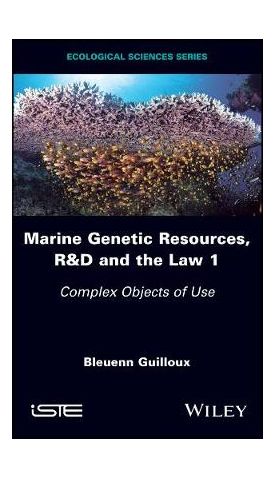אנו משתמשים ב-Cookies כדי לשפר את החוויה שלך. כדי לקיים ההנחיה החדשה של e-Privacy, עלינו לבקש את הסכמתך להגדיר את ה-Cookies. קבלת מידע נוסף.
808.00 ₪
Marine Genetic Resources, R&D and the Law 1: Complex Objects of Use
808.00 ₪
ISBN13
9781786302243
יצא לאור ב
London
זמן אספקה
21 ימי עסקים
עמודים
302
פורמט
Hardback
תאריך יציאה לאור
1 ביוני 2018
Advances in research and development reveal the immense diversity and potential of marine genetic resources. Under international law, no specific regime applies to these complex and paradoxical objects of use. The Law of the Sea Convention sets a framework that is partly inadequate for this new category of resources. The Biodiversity Convention and the Nagoya Protocol only address the genetic resources of national areas. Patents allow their holder to exercise a monopoly on exploiting biotechnological creations to extensive claims, questioning the common nature of biodiversity and related knowledge. They hinder research and the objectives of biodiversity law. The legal and practical rules of physical and functional access vary in geometry. They focus on the valorization of research results, crystallizing conflicts of interest between suppliers and users. Sustainable research and development is essential to the knowledge and protection of marine biodiversity. The qualification of marine genetic resources in common, standard contractual tools, distributed research and development infrastructures, negotiation of an agreement on sustainable use and conservation of biodiversity beyond the limits of national jurisdiction, would To remove these inconsistencies.
| עמודים | 302 |
|---|---|
| פורמט | Hardback |
| ISBN10 | 1786302241 |
| יצא לאור ב | London |
| תאריך יציאה לאור | 1 ביוני 2018 |
| תוכן עניינים | Foreword ix Introduction xi Chapter 1. The Scientific Representation of the Living World: A Dual Concept Between Nature's and Humans' Shares 1 1.1. Natural sciences: the given living world 2 1.1.1. Taxonomy: the observation of the living world 2 1.1.2. Systematics: the identification of the living world 10 1.2. Life sciences: the constructed living world 18 1.2.1. Biological sciences: the exploration of the living world 18 1.2.2. Bio-technosciences: the instrumentalization of the living world 25 Part 1. Singular Objects Moving Toward Reservation 35 Chapter 2. Exploitable Raw Materials 37 2.1. Genetic material: natural resources defined according to their conditions of appropriation 38 2.1.1. Appropriable natural things 41 2.1.2. Things on the verge of exclusive appropriation 45 2.2. Marine genetic resources: biological resources defined according to their destination 58 2.2.1. Traditional marine living resources exploited for food and industrial purposes 59 2.2.2. New marine biological resources searched for the purposes of scientific and biotechnological valorization 63 Chapter 3. Patentable Biotechnological Inventions 75 3.1. The patentability of life of any origin: an established principle 80 3.1.1. The uncontested patentability of inventions of microorganic origin 81 3.1.2. The logical acceptance of the patentability of inventions of macroorganic origin 87 3.2. The patentability of life in all its forms: a questionable reality 98 3.2.1. An overall commodification of the living world 99 3.2.2. A gradual privatization of research in life sciences 109 Part 2. Global Objects Moving Toward Sharing 117 Chapter 4. Residual Res Communes 119 4.1. Res communes due to disinterest 120 4.1.1. Non-appropriable things as a matter of principle 121 4.1.2. Things of common use 134 4.2. Common resources at risk 137 4.2.1. The tragedy of the genetic pool 138 4.2.2. The tragedy of the scientific "anticommons" 151 Chapter 5. Reconstructing the Commons 157 5.1. Renewal of the commons in a context of global interdependencies 160 5.1.1. Global public goods: a theoretical and global approach to the commons 162 5.1.2. Common-pool resources: a concrete and nuanced approach to the commons 166 5.2. An attempt to apply renewed figures of the commons to marine biodiversity and associated knowledge 172 5.2.1. A desirable communitarization 172 5.2.2. A communitarization difficult to implement 186 Conclusion 197 Appendices 199 Appendix 1. Classical Marine Bioprospecting: Biochemistry and Genetic Engineering 201 Appendix 2. Modern Marine Bioprospecting: Metagenomics 203 Appendix 3. The Drug Research and Development Steps 205 Appendix 4. Risk Assessment in the Bioprospecting Process 207 Appendix 5. Aleatory Component Comparison in Fishing and Bioprospecting 209 Appendix 6. Patent Claims Over Genes of Marine Origin 211 Appendix 7. Illustrative Database on Marine Biotechnological Innovations 213 Bibliography 231 Index 263 |
| זמן אספקה | 21 ימי עסקים |



Login and Registration Form